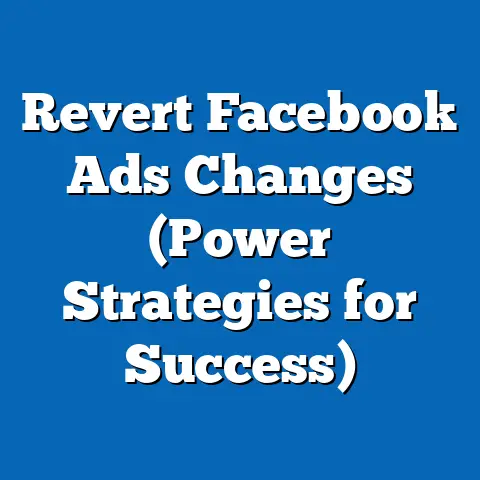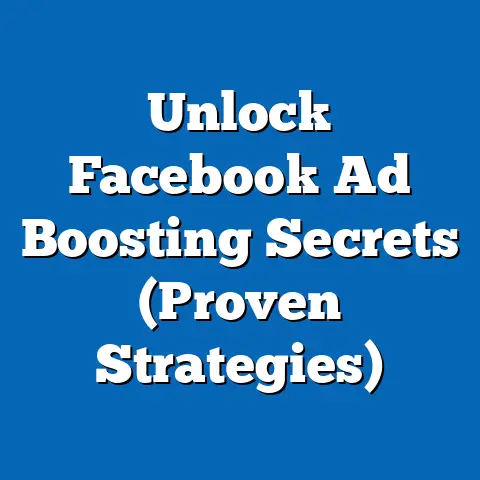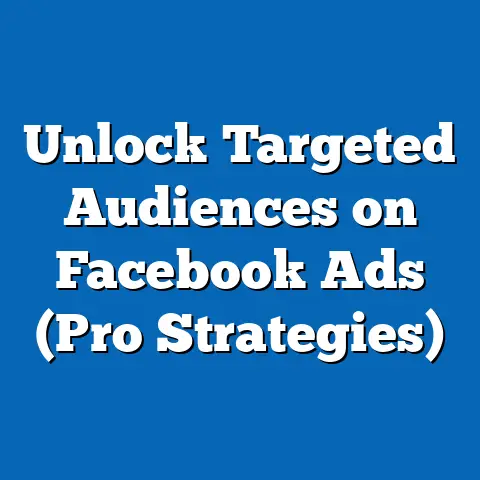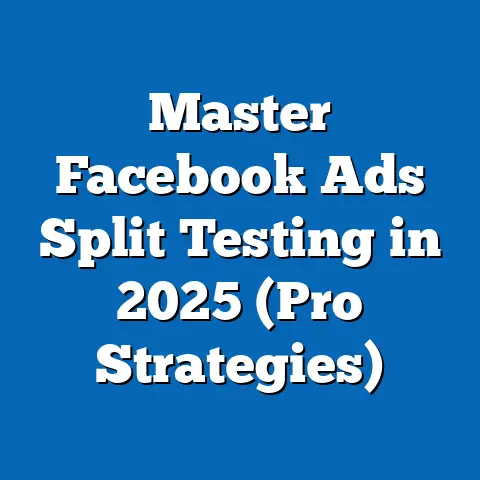Boost Group with Facebook Ads (Expert Strategies)
The digital marketing landscape is a constantly shifting terrain. What worked yesterday might be obsolete today. That’s why adaptability is the name of the game, especially when it comes to Facebook advertising. Businesses and communities alike need to continuously evolve their strategies to keep pace with the ever-changing dynamics of social media platforms. In my experience, one of the most powerful tools for boosting groups, whether for community engagement, brand loyalty, or even lead generation, is strategically leveraging Facebook Ads.
I’ve seen firsthand how a well-crafted Facebook ad campaign can transform a dormant group into a thriving hub of activity. It’s not just about throwing money at the problem; it’s about understanding the nuances of the platform, crafting compelling content, and targeting the right audience. This article isn’t just about the basics; it’s about delving into expert strategies that will help you maximize the effectiveness of your Facebook Ads and unlock the true potential of your group. Let’s dive in!
Understanding the Facebook Ads Ecosystem
Let’s start with a foundational understanding of what Facebook Ads are all about. At its core, Facebook Ads is a powerful advertising platform that allows you to reach a massive audience with targeted messaging. It’s not just about showing your ad to anyone and everyone; it’s about connecting with people who are genuinely interested in what your group has to offer.
Key components of the Facebook Ads ecosystem include:
- Targeting Options: This is where the magic happens. Facebook allows you to target users based on a wide range of factors, including demographics (age, location, gender), interests (hobbies, pages they like), behaviors (purchase history, online activity), and even custom audiences (people who have interacted with your website or email list).
- Ad Formats: From simple image ads to engaging video ads and interactive carousel ads, Facebook offers a variety of formats to suit your message and target audience.
- Facebook Ads Manager: This is your control center. It’s where you create, manage, and analyze your ad campaigns. It provides valuable insights into your ad performance, allowing you to optimize your campaigns for better results.
But understanding these components is only half the battle. You also need to understand how Facebook’s algorithm influences ad performance and group visibility. The algorithm is constantly learning and adapting based on user behavior. It prioritizes content that it believes users will find engaging and relevant. This means that your ads need to be not only well-targeted but also genuinely engaging to stand out from the crowd and capture the attention of your target audience.
Takeaway: Facebook Ads is a powerful tool, but it’s crucial to understand its core components and how the platform’s algorithm works to maximize your ad performance.
Defining Your Group’s Objectives
Before you even think about creating your first ad, you need to define your group’s objectives. What do you want to achieve by using Facebook Ads to boost your group? Are you looking to increase membership? Enhance engagement? Drive traffic to a website?
Setting clear, measurable objectives is crucial for several reasons:
- It provides direction: Knowing what you want to achieve helps you focus your efforts and create ads that are aligned with your goals.
- It allows you to measure success: Without clear objectives, it’s impossible to determine whether your ad campaigns are actually working.
- It informs your ad strategies: Different objectives require different strategies. For example, if you’re looking to increase membership, you’ll need to create ads that highlight the benefits of joining your group. If you’re looking to enhance engagement, you’ll need to create ads that encourage interaction and discussion.
Here are some examples of different objectives and how they can inform your ad strategies:
- Objective: Increase group membership by 20% in the next month.
- Ad Strategy: Create ads that highlight the value of joining the group, such as exclusive content, networking opportunities, or access to expert advice.
- Objective: Increase engagement (likes, comments, shares) by 15% in the next two weeks.
- Ad Strategy: Create ads that ask questions, encourage discussion, or offer incentives for participation.
- Objective: Drive 100 new leads to a website through group membership in one quarter.
- Ad Strategy: Create ads that promote valuable content (e.g., a free ebook or webinar) and require users to join the group to access it.
- Ad Strategy: Create ads that highlight the value of joining the group, such as exclusive content, networking opportunities, or access to expert advice.
- Ad Strategy: Create ads that ask questions, encourage discussion, or offer incentives for participation.
- Ad Strategy: Create ads that promote valuable content (e.g., a free ebook or webinar) and require users to join the group to access it.
Having a target audience in mind before creating ads is also essential. Who are you trying to reach? What are their interests, needs, and pain points? The more you know about your target audience, the better you can tailor your ads to resonate with them.
Takeaway: Clearly define your group’s objectives and target audience before creating any ads. This will help you focus your efforts and create ads that are more likely to achieve your goals.
Crafting Compelling Ad Content
Now that you know your objectives and target audience, it’s time to start crafting compelling ad content. This is where your creativity comes into play. Your ads need to grab attention, communicate your message effectively, and persuade people to take action.
Here are some key elements of compelling ad content:
- Visuals: A picture is worth a thousand words. Use high-quality images or videos that are relevant to your message and target audience.
- Copywriting: Your ad copy should be clear, concise, and persuasive. Highlight the benefits of joining your group and address any potential concerns.
- Calls-to-Action (CTAs): Tell people what you want them to do. Use strong CTAs like “Join Now,” “Learn More,” or “Get Access.”
I’ve found that A/B testing different ad creatives is crucial for determining what works best for a particular group. This involves creating multiple versions of your ad with slight variations in the visuals, copy, or CTAs, and then running them simultaneously to see which performs best. This allows you to refine your ad content over time and optimize it for maximum impact.
For example, you could test two different images to see which one generates more clicks. Or you could test two different headlines to see which one is more engaging. The key is to only change one element at a time so you can accurately measure the impact of each change.
Takeaway: Craft compelling ad content that resonates with your target audience. Use high-quality visuals, persuasive copywriting, and strong CTAs. A/B test different ad creatives to optimize your ads for maximum impact.
Targeting the Right Audience
As I mentioned earlier, targeting is where the magic happens. Facebook offers a plethora of targeting options, allowing you to reach a highly specific audience.
Here are some of the most important targeting options to consider:
- Demographics: Target users based on age, location, gender, education, and other demographic factors.
- Interests: Target users based on their interests, hobbies, and pages they like on Facebook.
- Behaviors: Target users based on their online activity, purchase history, and other behaviors.
- Custom Audiences: Create custom audiences based on your existing customer data, such as email lists or website visitors.
- Lookalike Audiences: Reach new members who are similar to your existing engaged members. This is a particularly powerful strategy for expanding your reach and attracting new members who are likely to be interested in your group.
Retargeting strategies can also be incredibly effective for re-engaging users who have interacted with your group or related content. For example, you could retarget users who have visited your website but haven’t yet joined your group. Or you could retarget users who have liked or commented on your Facebook posts but haven’t yet become members.
Takeaway: Utilize Facebook’s targeting options to reach the right audience for your group. Consider using lookalike audiences and retargeting strategies to expand your reach and re-engage users who have already shown interest in your group.
Analyzing and Optimizing Ad Performance
Creating great ads and targeting the right audience is only the first step. You also need to analyze your ad performance to gauge success and identify areas for improvement.
Key metrics to track include:
- Click-Through Rate (CTR): The percentage of people who see your ad and click on it.
- Engagement Rate: The percentage of people who interact with your ad (likes, comments, shares).
- Conversion Rate: The percentage of people who take the desired action after clicking on your ad (e.g., joining your group).
- Cost Per Click (CPC): The average cost you pay for each click on your ad.
- Cost Per Acquisition (CPA): The average cost you pay for each new member or lead you acquire through your ads.
The Facebook Ads Manager provides a wealth of data and insights into your ad performance. Use this data to identify which ads are performing well and which ones need improvement. Don’t be afraid to experiment with different ad creatives, targeting options, and bidding strategies to optimize your campaigns for better results.
For instance, if you notice that your CTR is low, you might need to improve your ad copy or visuals. If you notice that your CPA is high, you might need to refine your targeting or adjust your bidding strategy.
Takeaway: Continuously analyze your ad performance and optimize your campaigns based on the data. Don’t be afraid to experiment and try new things to improve your results.
Advanced Strategies for Group Growth
Once you’ve mastered the basics, you can start exploring more advanced strategies for group growth.
One powerful strategy is to use the Facebook Pixel for tracking and optimizing conversions. The Facebook Pixel is a piece of code that you can install on your website to track user behavior. This allows you to see which ads are driving the most valuable traffic to your website and optimize your campaigns accordingly.
Another advanced strategy is to integrate Facebook Ads with other marketing channels, such as email marketing and influencer collaborations. For example, you could use Facebook Ads to promote your email newsletter and then use your email newsletter to promote your Facebook group. Or you could partner with influencers in your niche to promote your group to their followers.
Fostering community engagement through ads and encouraging user-generated content is also essential for long-term group growth. Create ads that encourage members to share their experiences, ask questions, and participate in discussions. The more engaged your members are, the more likely they are to stay active in your group and recommend it to others.
Takeaway: Explore advanced strategies such as using the Facebook Pixel, integrating Facebook Ads with other marketing channels, and fostering community engagement to maximize your group growth.
Conclusion
In conclusion, boosting your group with Facebook Ads requires a strategic and adaptable approach. It’s not just about creating ads and hoping for the best; it’s about understanding the platform, defining your objectives, crafting compelling content, targeting the right audience, and continuously analyzing and optimizing your performance.
I encourage you to implement the expert strategies outlined in this article and to continuously refine your approach based on performance data and audience feedback. The digital marketing landscape is constantly evolving, so it’s crucial to stay up-to-date with the latest trends and best practices.
Remember, the potential for growth and engagement through effective Facebook advertising is immense. By leveraging these strategies, you can transform your group into a thriving community that provides value to its members and helps you achieve your business goals. So, go out there, experiment, and see what works best for your group! The possibilities are endless.




